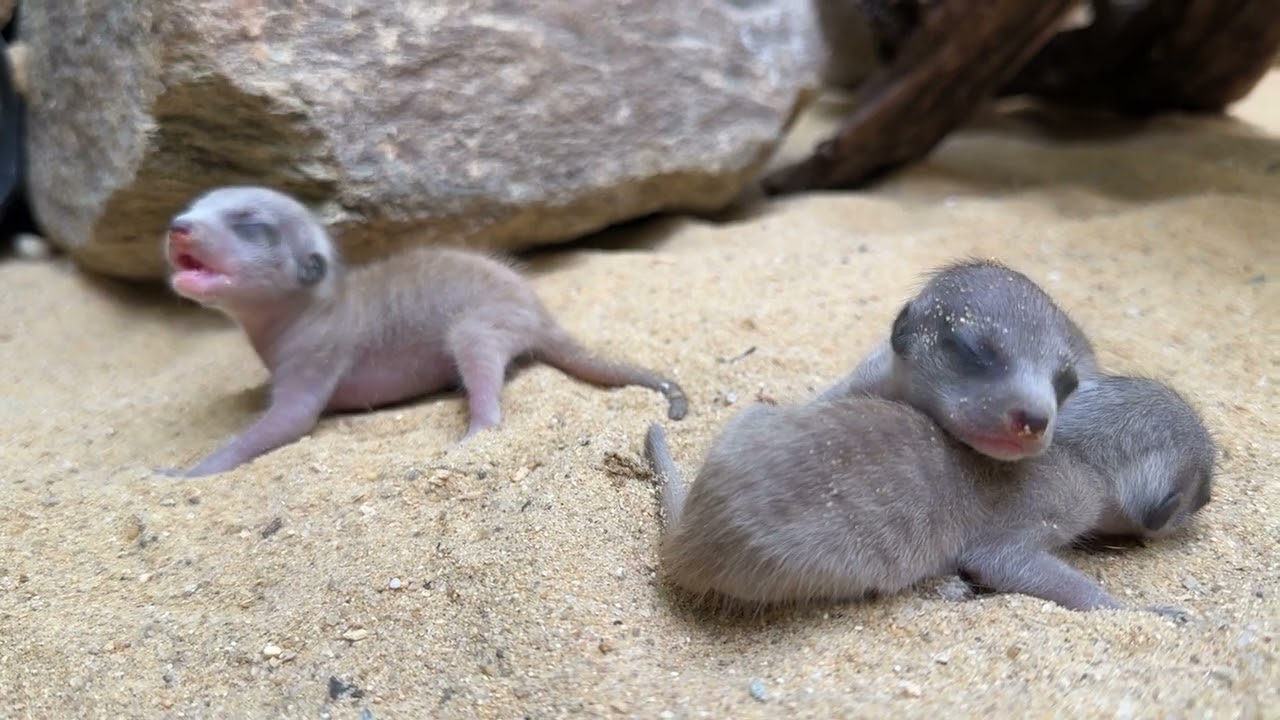Smithsonian’s National Zoo and Conservation Biology Institute celebrates the birth of three meerkats after 16 years.
The Smithsonian’s National Zoo and Conservation Biology Institute (NZCBI) recently welcomed the birth of three meerkats, an occasion that had not occurred in the past 16 years. On May 10, keepers reported that 5-year-old Sadie gave birth overnight and that the newborns are 14 days old at present. The meerkat pups are the first offspring for Sadie, while their father, 6-year-old Frankie, had previously sired offspring in his previous zoo.
A recommendation from the Association of Zoos and Aquariums’ Species Survival Plan (SSP) prompted NZCBI to breed Sadie and Frankie. Meerkats typically live in groups called mobs that consist of 10 to 15 individuals, although the giant mob can have up to 30 members. The Small Mammal House is where visitors can view NZCBI’s meerkat mob, which includes Sadie’s sister, Stella.
Natural Burrowing Behaviour exhibited by Meerkats at Smithsonian’s National Zoo.
In the wild, meerkat pups typically remain in an underground burrow for an average of three weeks. To encourage the meerkats to display their natural burrowing behavior, the Small Mammal House put a tubing system concealed within rockwork along the outskirts of its habitat. An underground sleeping chamber is located at the end of the tubing system. This design offers visitors a view of the meerkats’ underground sleeping space.
Sadie surprised the keepers by bringing her pups into the main exhibit space on the day she gave birth instead of keeping them in the underground burrow. The animal care staff, however, decided to let the mob bond and care for the pups without any interference. So far, they have noticed Sadie nursing her offspring, which seem healthy and strong.
Observations from Keepers at Smithsonian’s National Zoo
The keepers and veterinarians at the Smithsonian’s National Zoo closely monitor the family, but they are not handling the pups. As a result, determining the sex of the pups may take some time. Presently, the pups are taking their first steps outside of the nest and are beginning to explore their habitat.
Meerkats at NZCBI’s National Zoo: A Must-See for All Visitors
The meerkats offer an exciting peek into the natural behavior of these animals in the wild, typically not seen by humans. Visitors to the National Zoo and Conservation Biology Institute can tour the meerkat habitat and catch glimpses of the pups exploring their environment alongside their mob. Smithsonian’s National Zoo and Conservation Biology Institute encourages visitors to come and witness the unusual family time in the Small Mammal House and the playful and curious demeanor of the meerkats.
Final Word
The Smithsonian’s National Zoo and Conservation Biology Institute will continue to monitor the family of meerkats for the survival of the newborn pups and the well-being of their mob. The breeding of these animals is part of the species’ survival plan, and the knowledge gained from observation of these pups in the care of their mob will assist in keeping this beautiful species thriving.
*****
Summary of Description:
For the first time in 16 years, the Smithsonian’s National Zoo and Conservation Biology Institute (NZCBI) in Washington, D.C., has welcomed the birth of three meerkats. The mother, Sadie, gave birth on May 10, and her offspring appeared healthy and robust. Visitors to the Small Mammal House can view the meerkat mob, including Sadie’s sister, Stella, who also lives with them. They are left alone to bond with their mother and explore their habitat.
*****
*****
Source Description
For the first time in 16 years, the Smithsonian’s National Zoo and Conservation Biology Institute (NZCBI) in Washington, D.C., is celebrating the birth of three meerkats. Keepers in the Small Mammal House reported for duty the morning of May 10 and observed that 5-year-old Sadie had given birth overnight. NZCBI had received a recommendation from the Association of Zoos and Aquariums’ Species Survival Plan (SSP) to breed Sadie and the pups’ 6-year-old father, Frankie. These pups are the first offspring for Sadie; Frankie sired offspring previously at his former zoo. Meerkats live in groups called mobs that can include as many as 30 individuals, although the average mob size is around 10 to 15 individuals. Visitors can view NZCBI’s meerkat mob at the Small Mammal House, including Sadie’s sister, Stella.
The day Sadie gave birth, she surprised keepers by bringing her pups into the main exhibit space. Meerkat pups typically remain in an underground burrow for about three weeks in the wild. To encourage the meerkats to exhibit their natural burrowing behavior, a tubing system—concealed within rockwork—runs along the outskirts of their habitat in the Small Mammal House. At the end of the tunnel, a nest box offers visitors a view of the meerkats’ underground sleeping chamber.
Animal care staff are leaving the mob to bond with and care for the pups without interference. They closely monitor the family and have observed Sadie nursing her offspring, which appear healthy and robust. Because keepers and veterinarians are not handling the pups, it may be time before they can determine their sexes. Now 14 days old, the pups are starting to open their eyes and explore their habitat.
MORE: https://nationalzoo.si.edu/news/meerkats-are-born-smithsonians-national-zoo-and-conservation-biology-institute.


